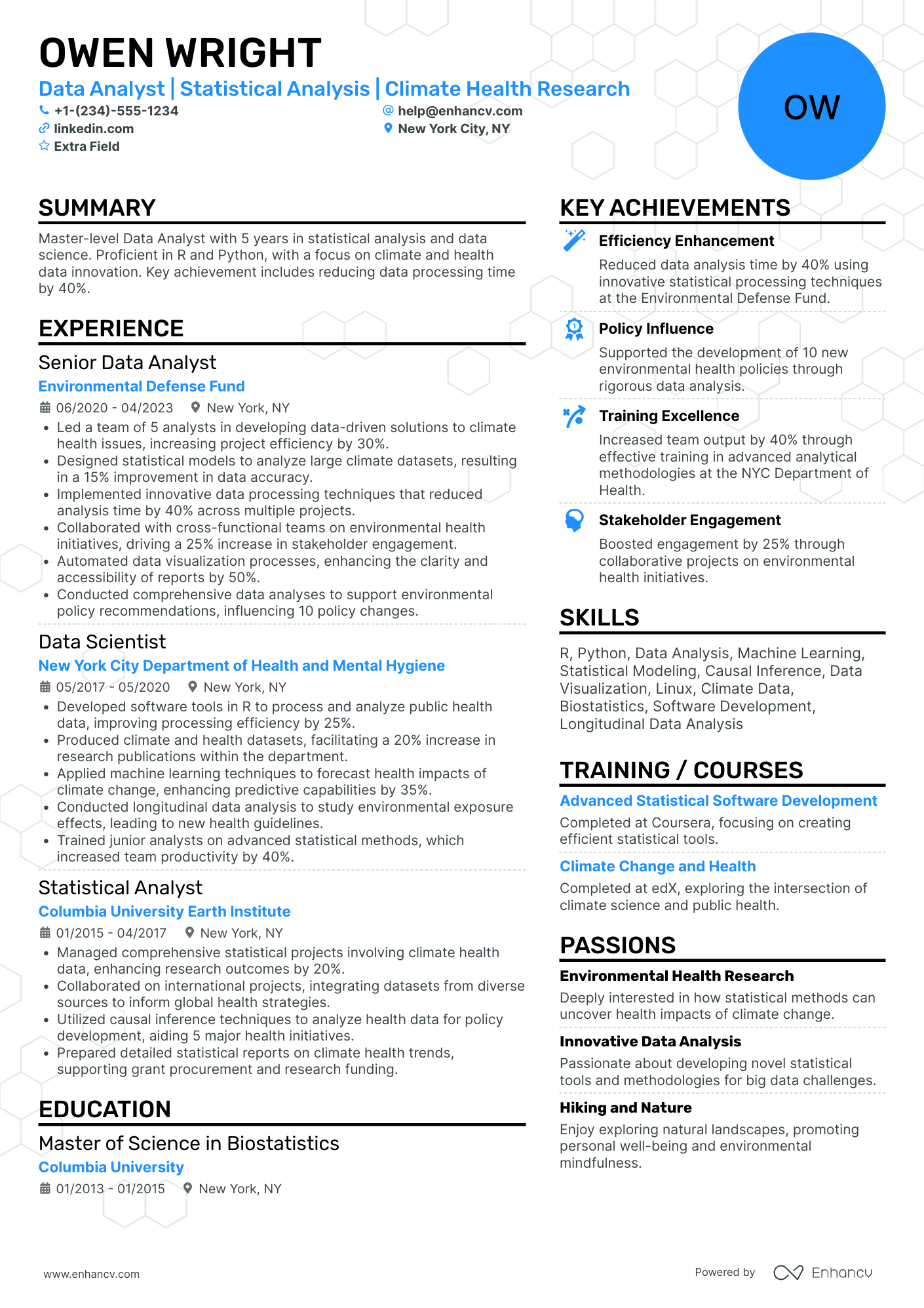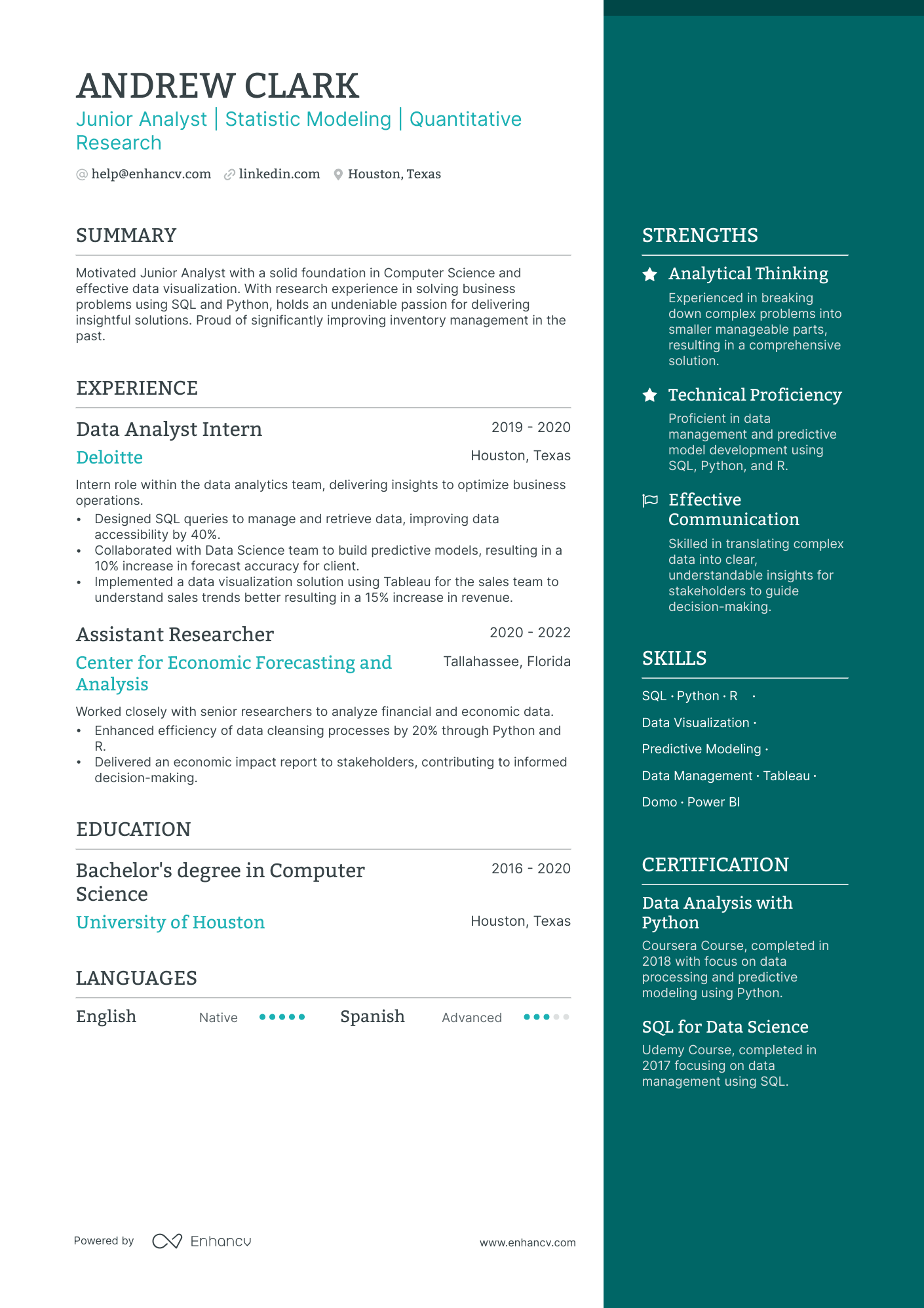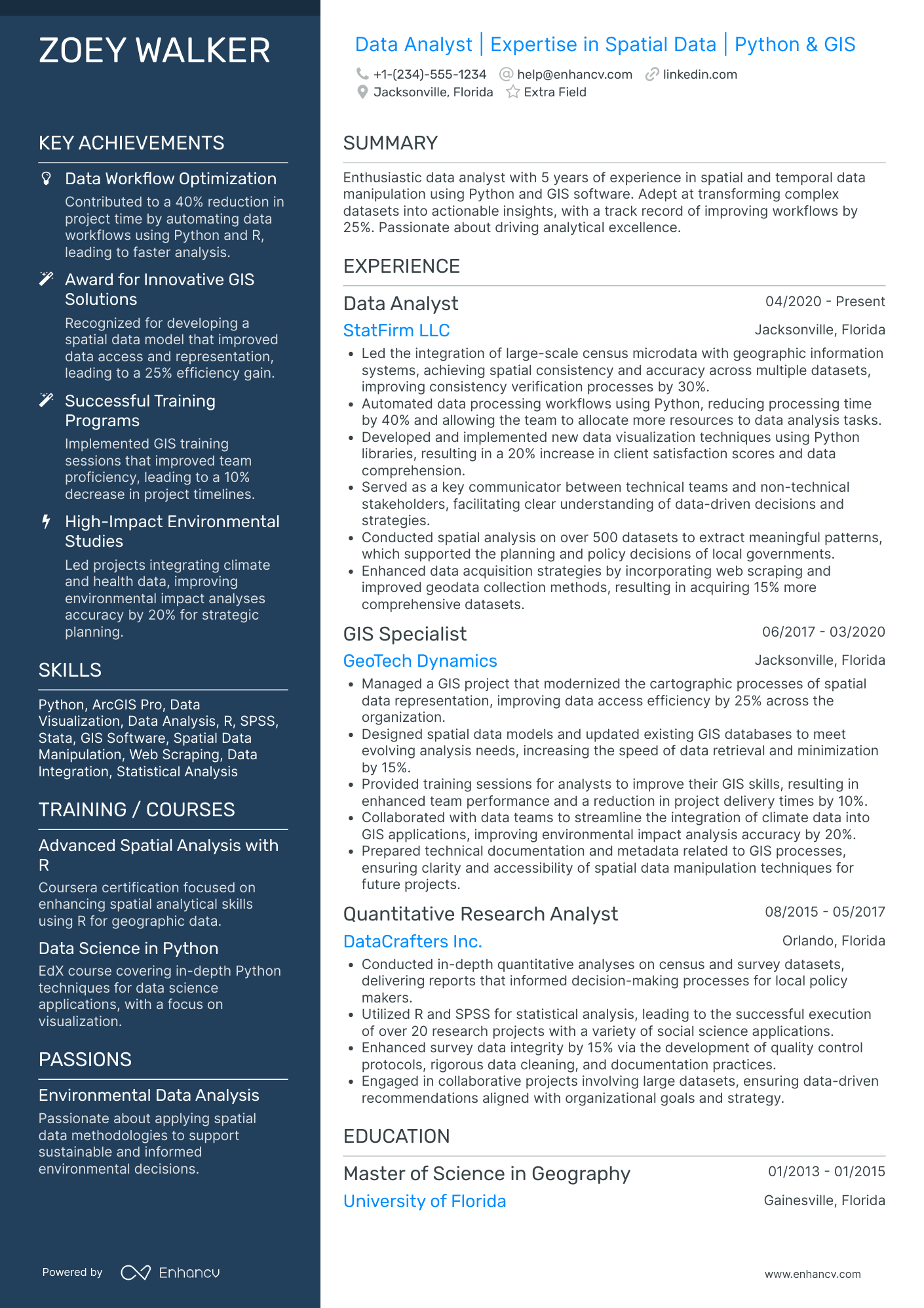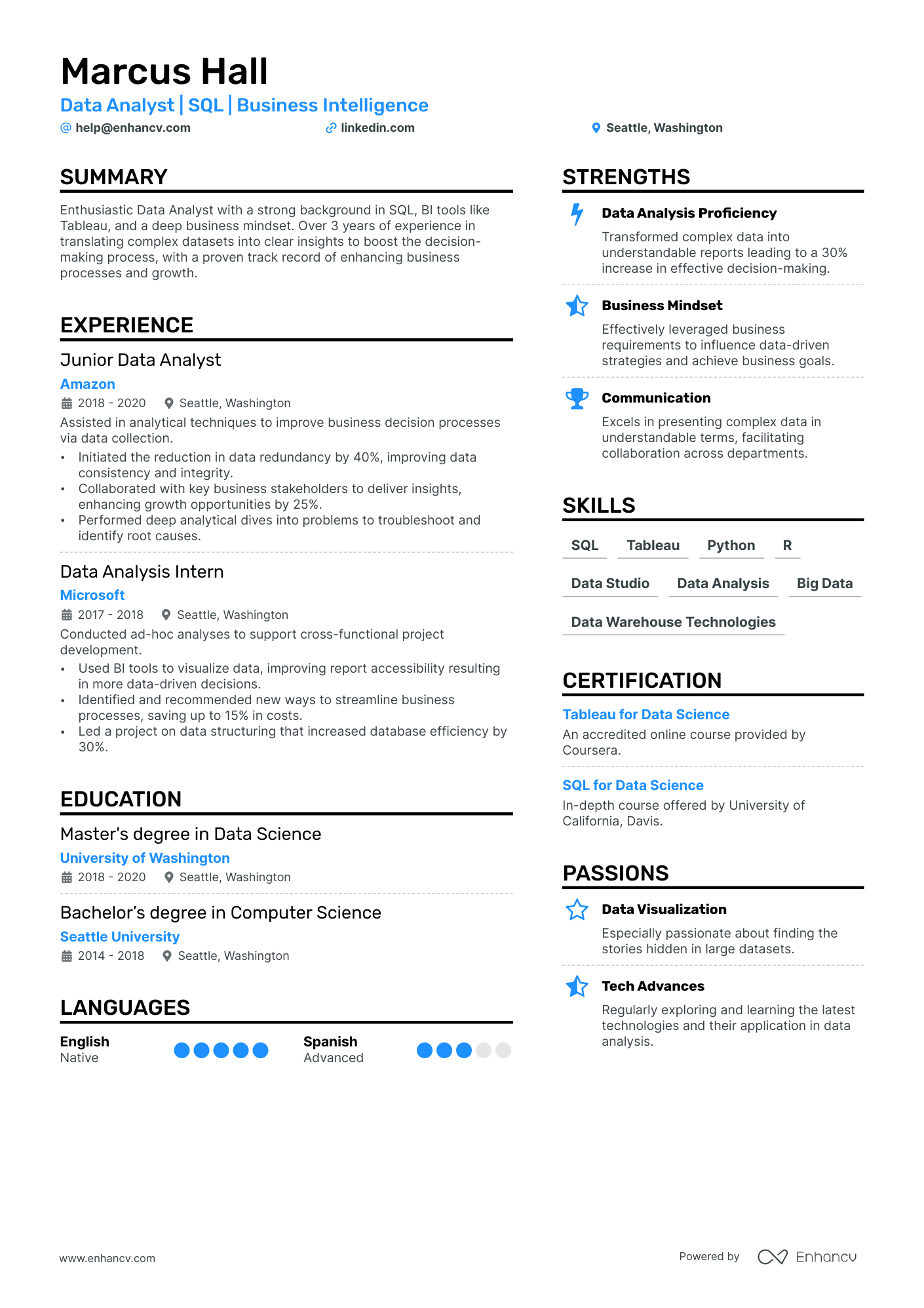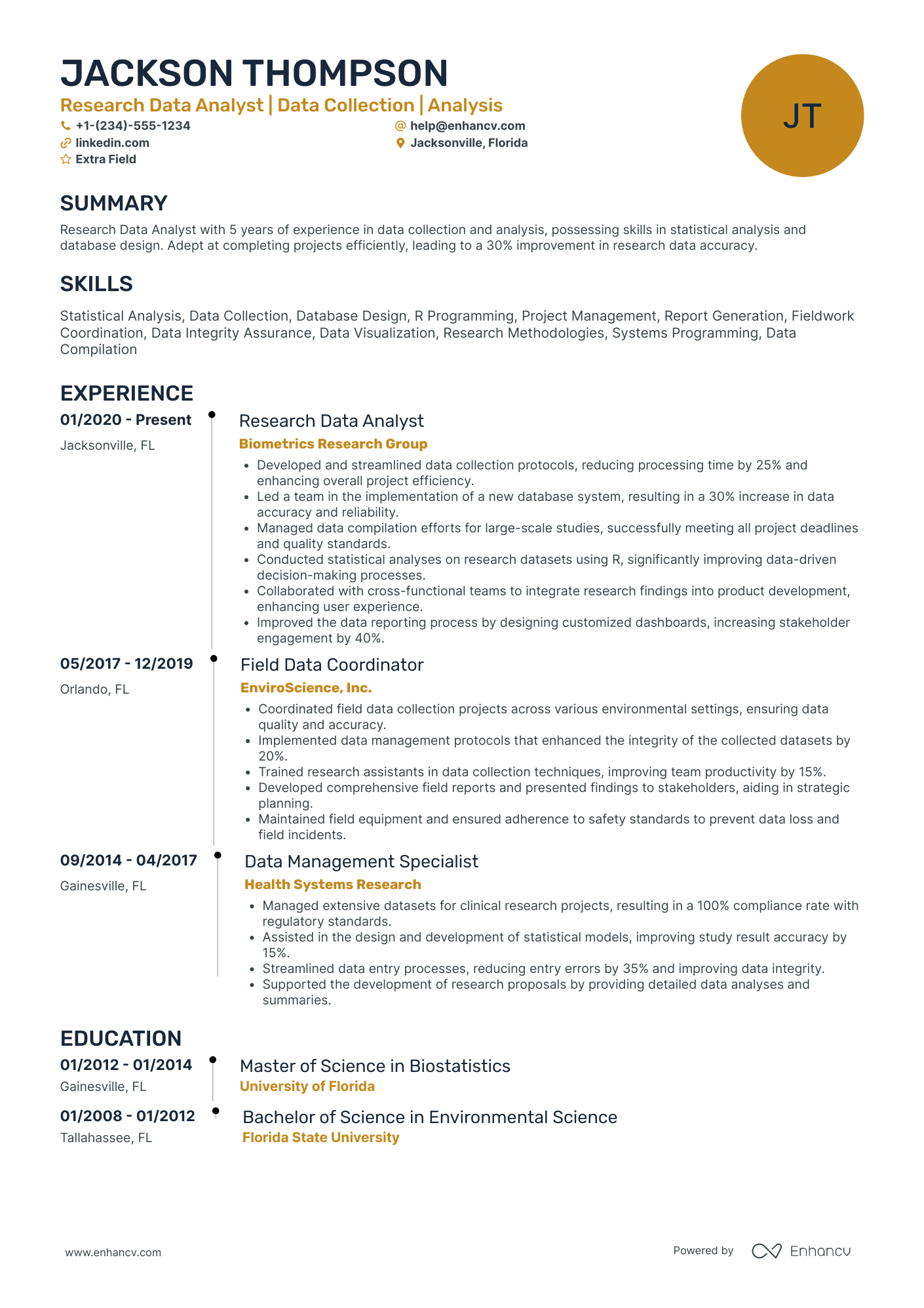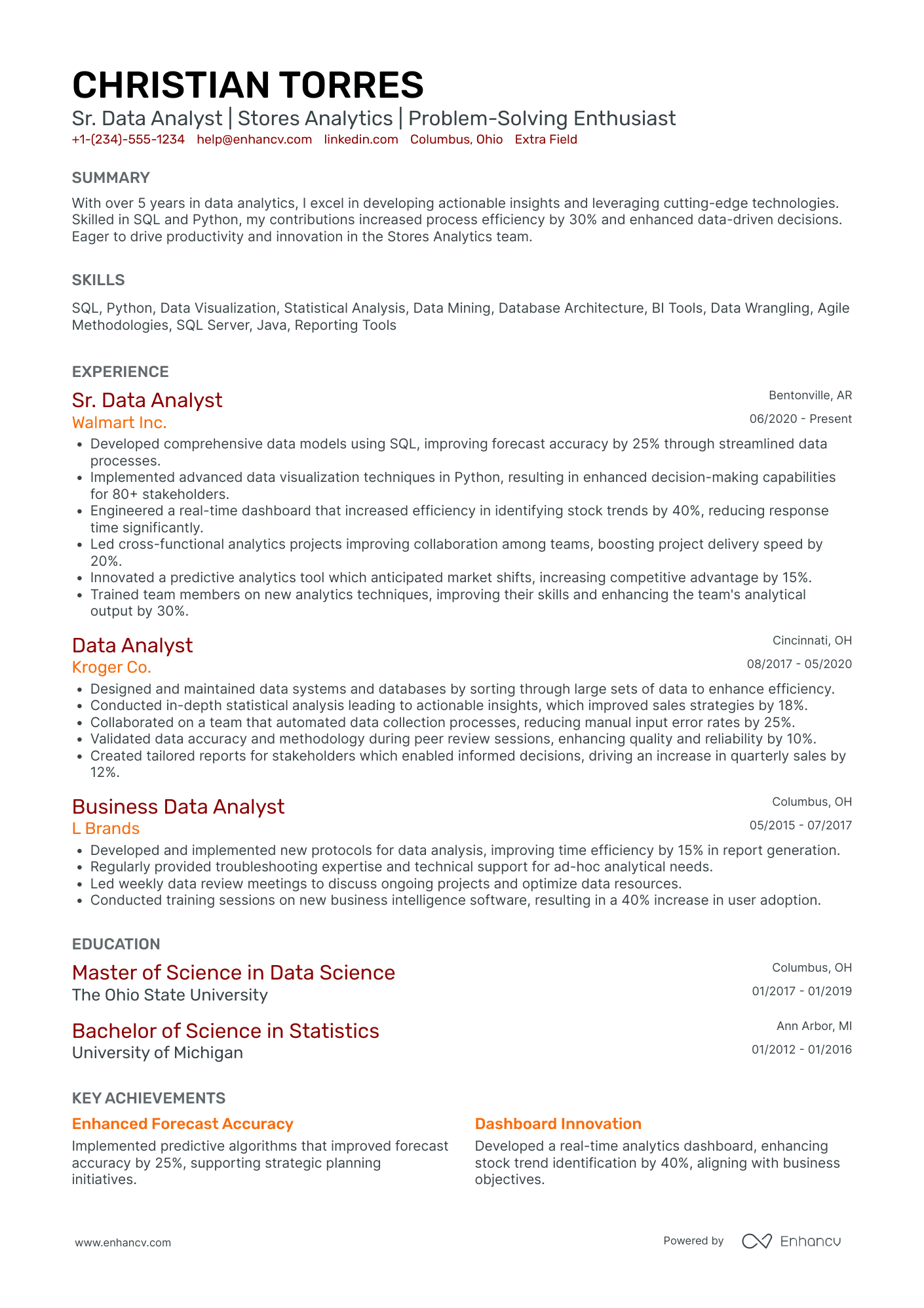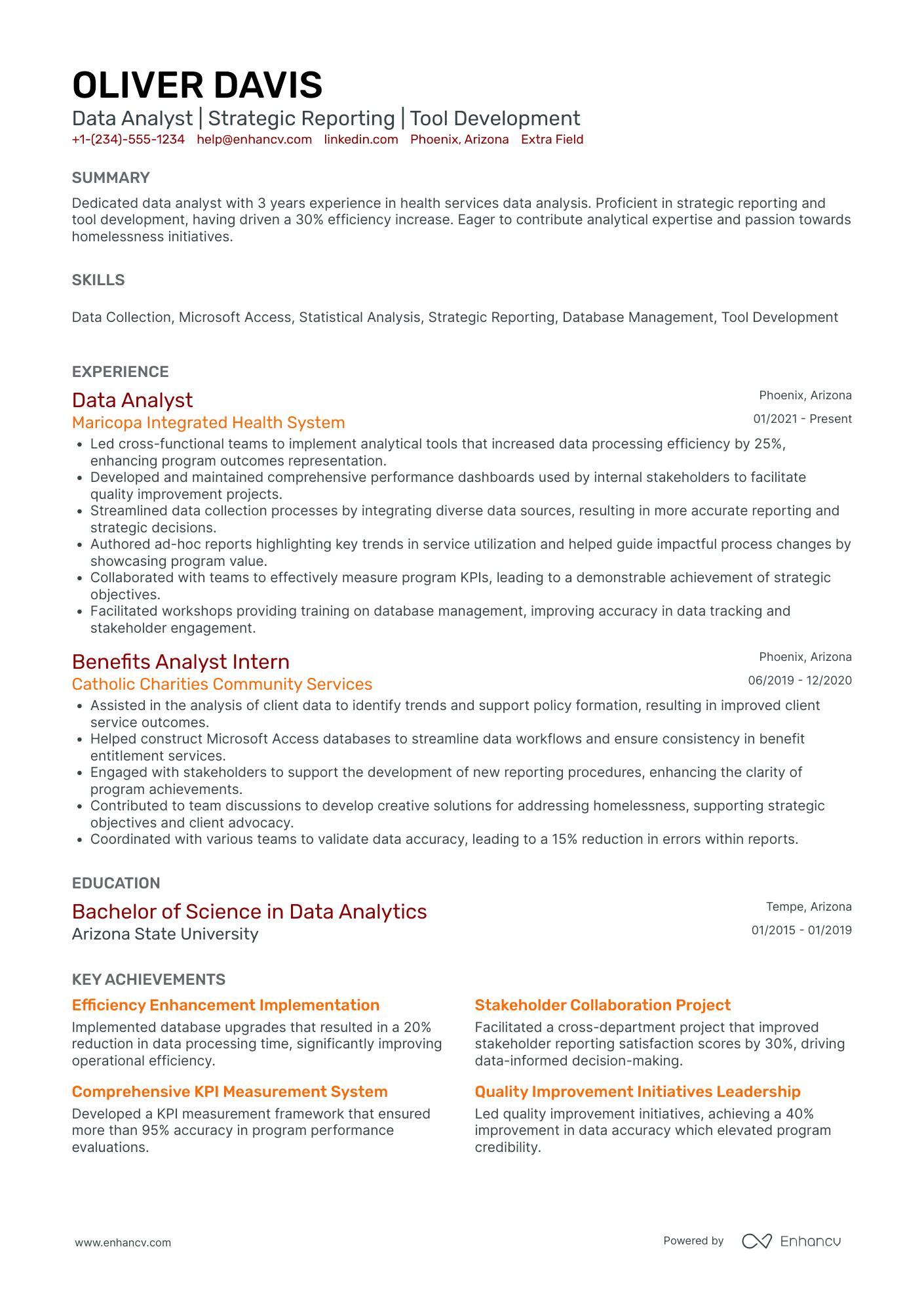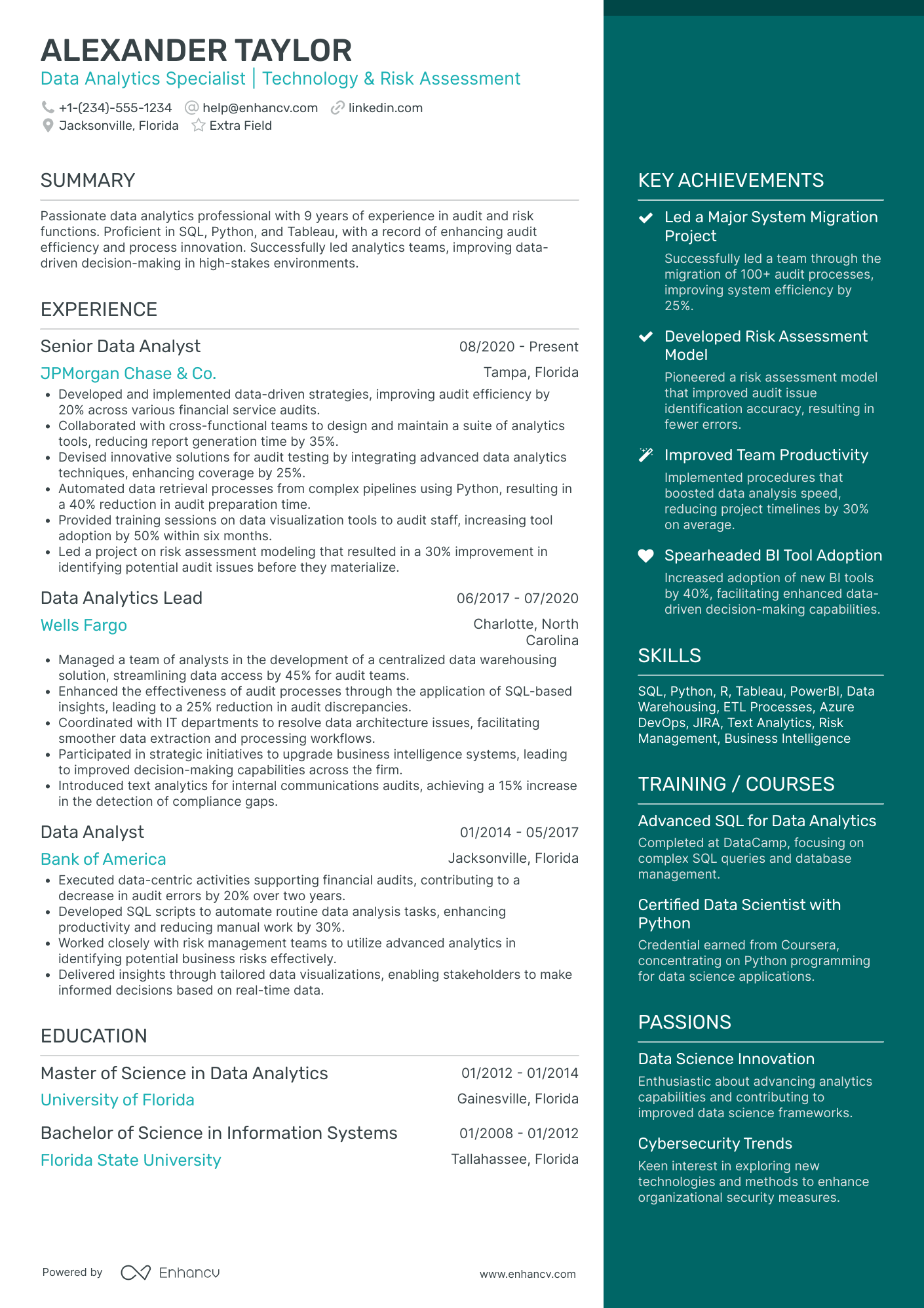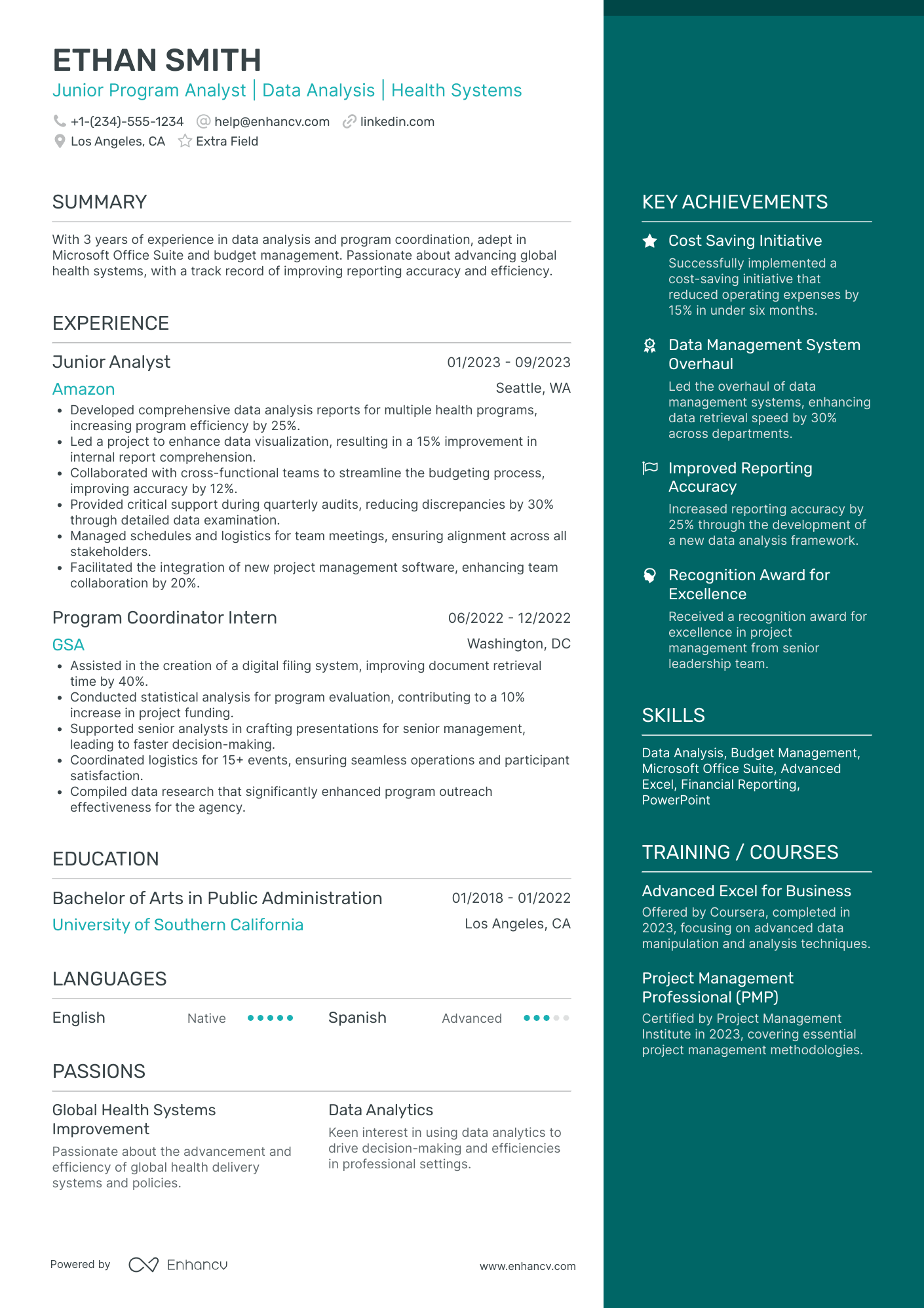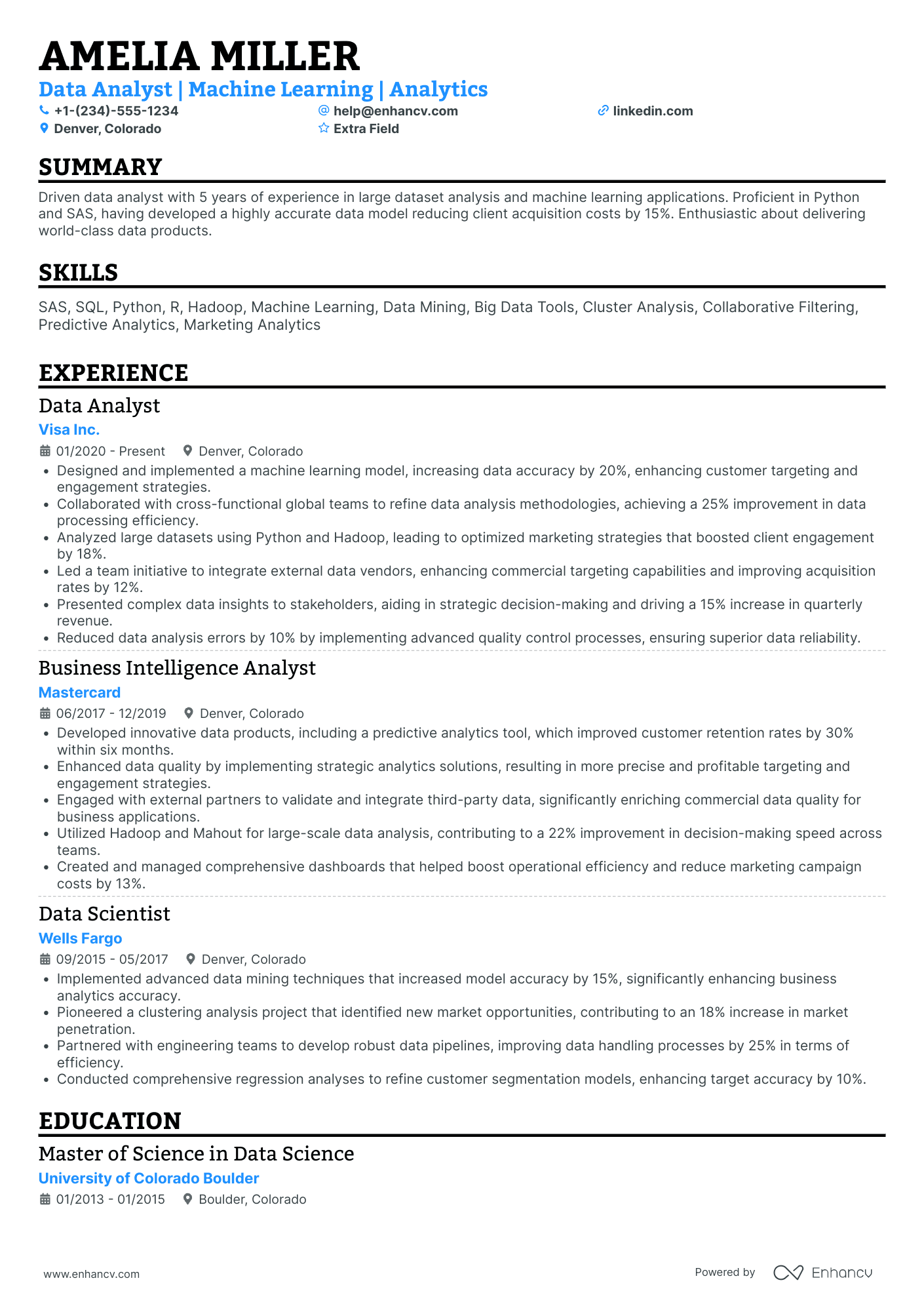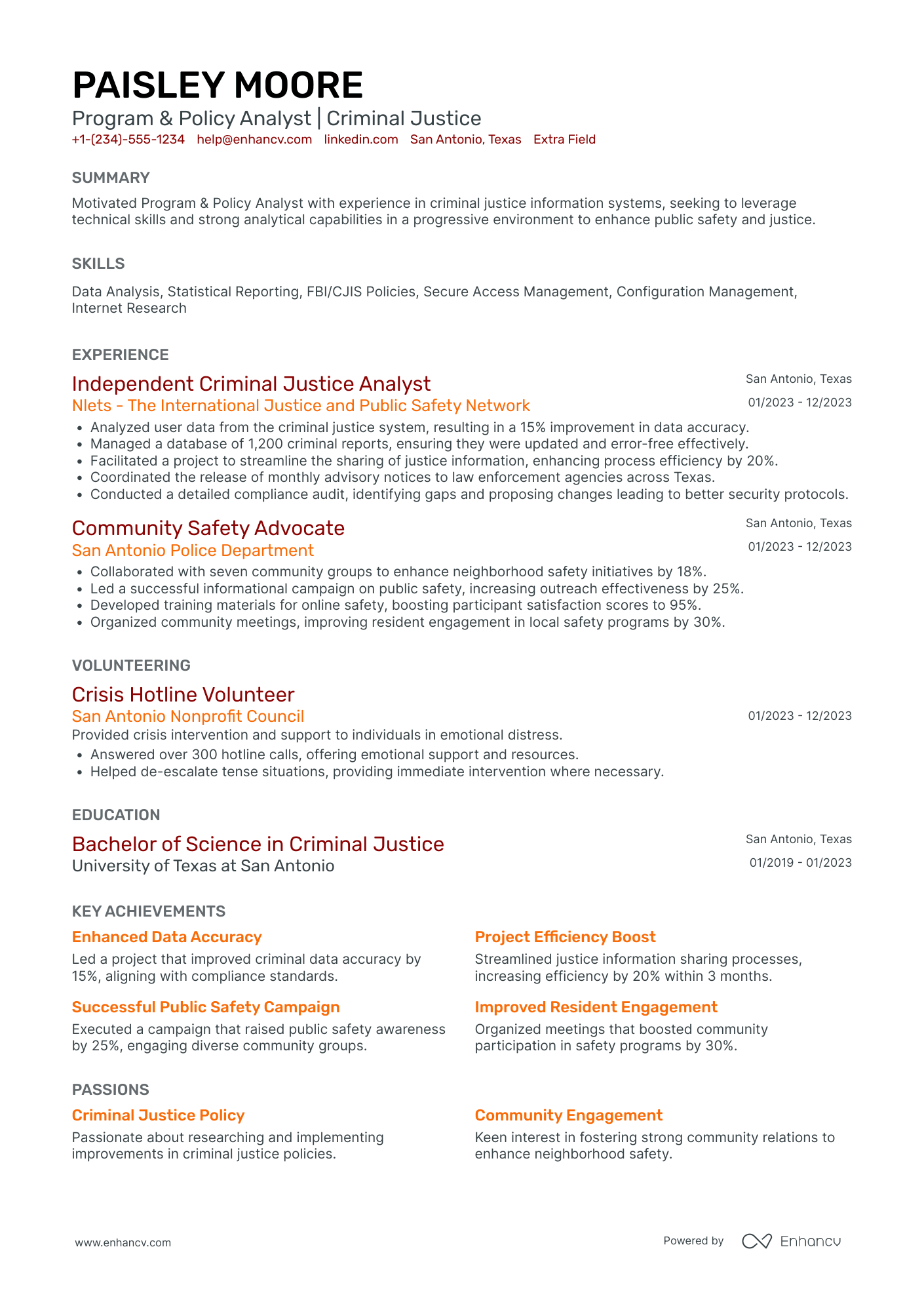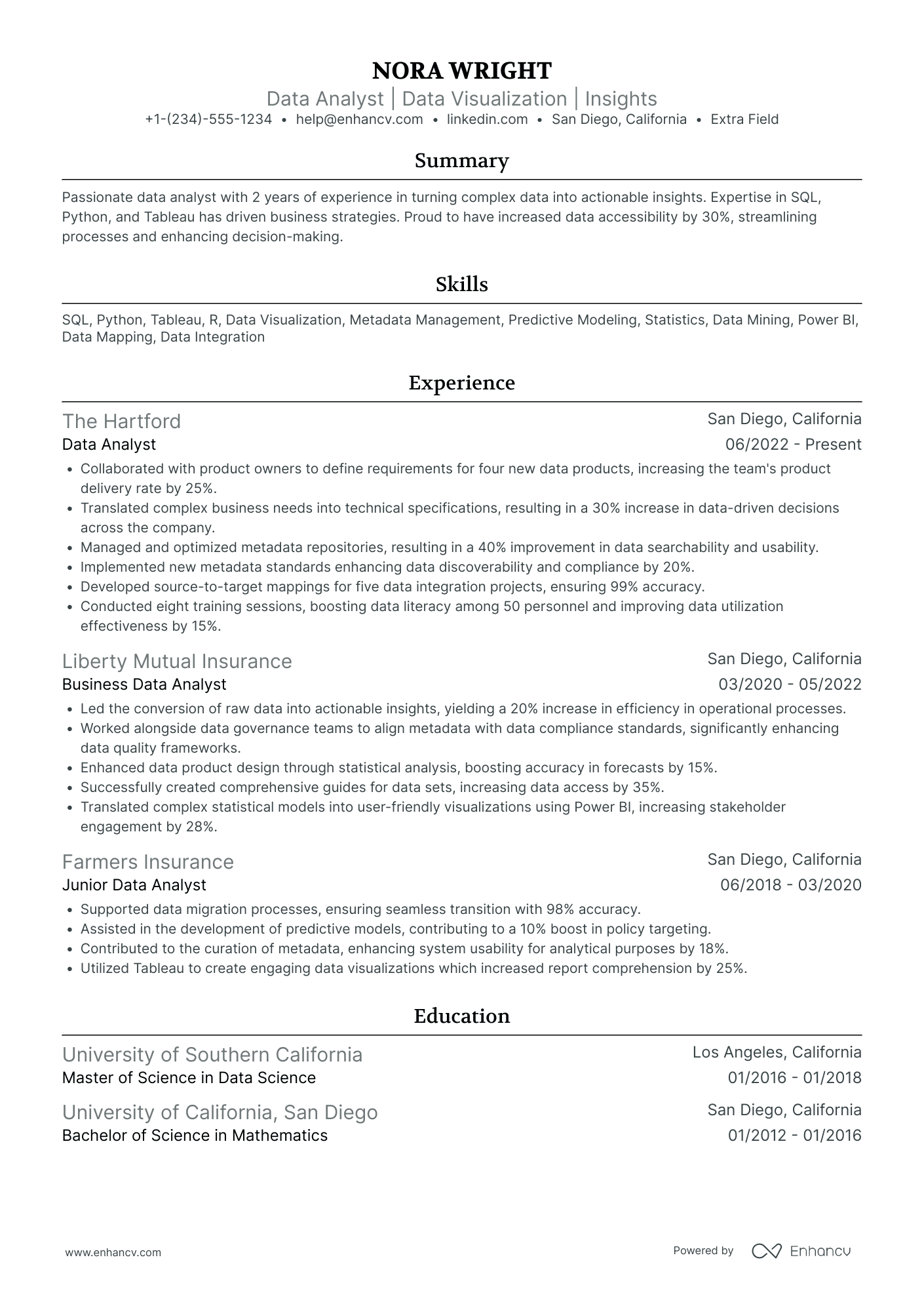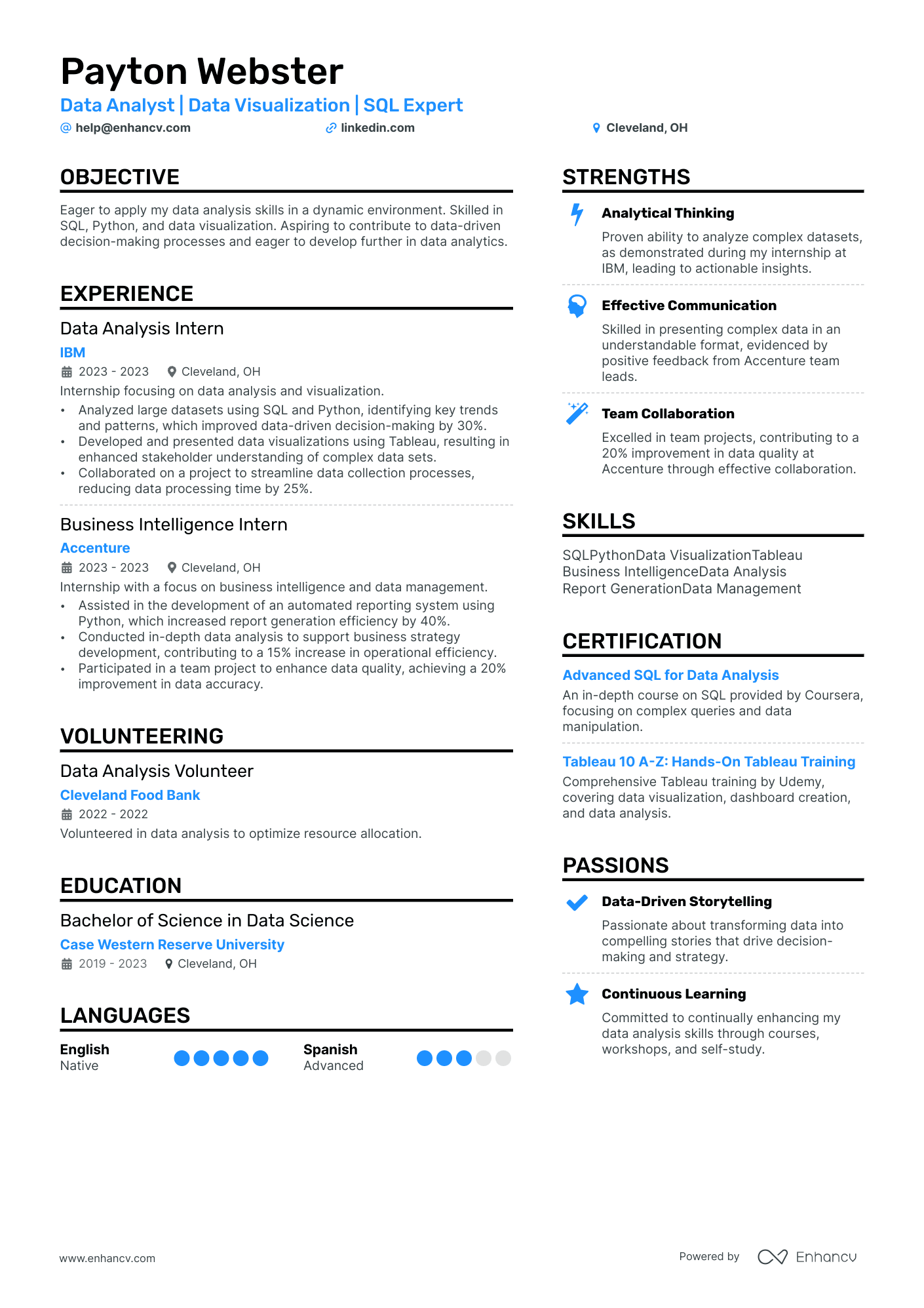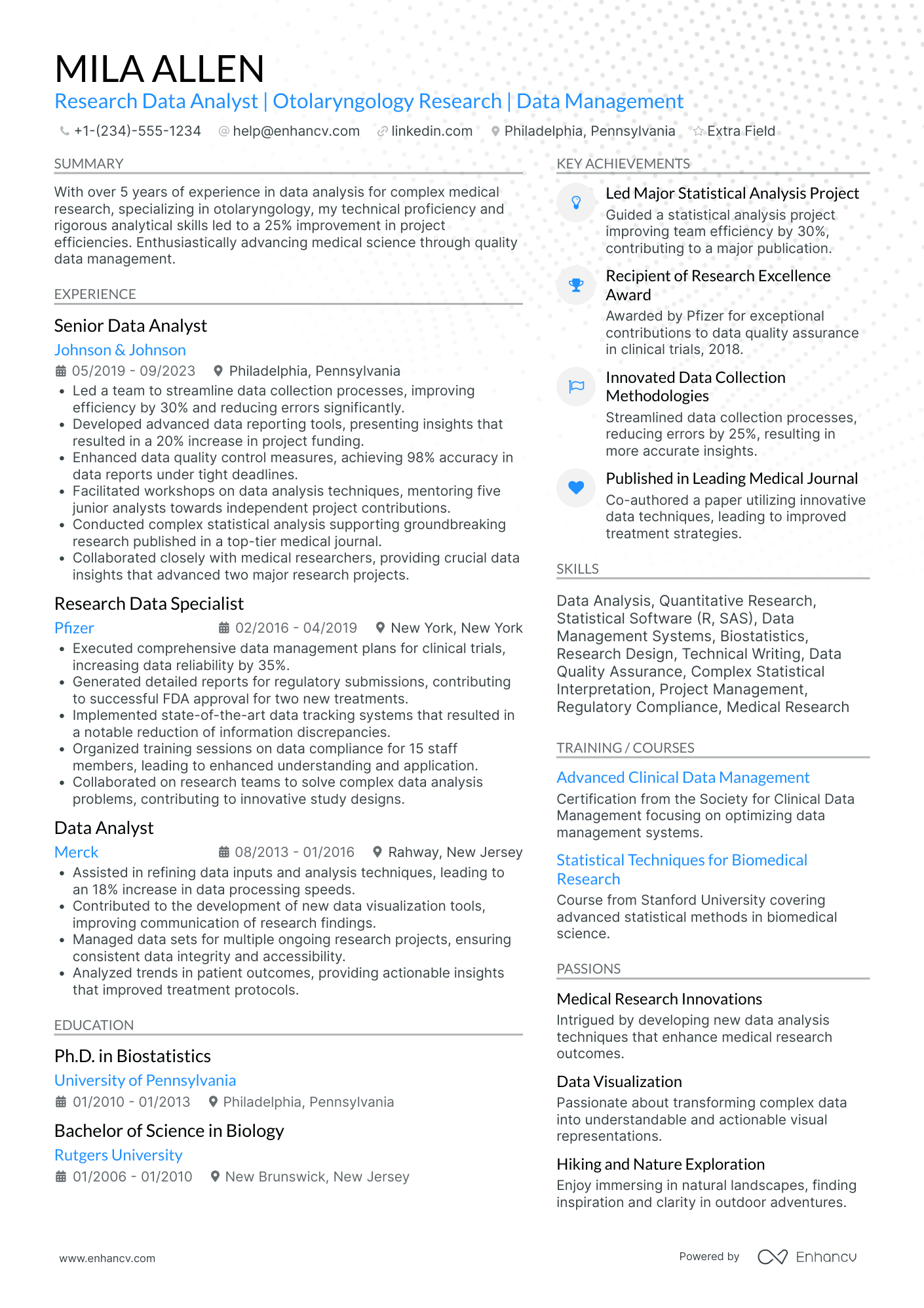All data tells a story. Data analysts search for this hidden narrative to effectively share it with others. Creating an entry-level data analyst resume is a very similar endeavor. Its purpose is to present data and facts, including education, work experiences, skills, and certifications, ensuring the narrative illustrates your suitability for a particular entry-level data analyst position.
Whether you're a recent graduate or starting a new career path, you can draw upon numerous practical and transferable skills to construct this narrative. This resume writing guide, including excellent examples and pro tips, will help you highlight these skills and overcome some of the biggest challenges to writing an entry-level data analyst resume, such as:
- Targeting your resume to particular jobs
- Following best practices to ensure formatting is ATS-optimized.
- Creating a thorough skills section reflecting both hard and soft skills.
- Showcasing your qualifications to demonstrate your potential to succeed without prior data analyst experience.
For even more examples from the data analysis field, check out these additional resources:
- Data analyst entry-level cover letter
- Junior data analyst resume
- Data analyst intern resume
- Data analyst resume
Entry-level data analyst resume example
Here's what this applicant does well in their resume:
- Specific achievements: The applicant effectively highlights specific, quantifiable achievements, such as improving data-driven decision-making by 30% at IBM and increasing report generation efficiency by 40% at Accenture, demonstrating their impact in previous roles.
- Relevant skills and certifications: Skills like SQL, Python, and data visualization are emphasized and correspond with relevant certifications such as Advanced SQL for Data Analysis and Tableau training. This alignment showcases the applicant's expertise in the field of data analysis.
- Experience diversity: The applicant's experience ranges from internships in data analysis and business intelligence to volunteering in data analysis at a food bank. This illustrates their soft skills, such as adaptability and versatility when employing their broad skill set.
How to format an entry-level data analyst resume
Competition for entry-level data analyst jobs can be fierce. A great way to ensure your resume immediately grabs the attention of employers is through its formatting.
Resume formatting demonstrates skills such as attention to detail, effective communication of data, and creative data visualization. This presents an opportunity to make a positive first impression on employers.
Include these essential elements when formatting your entry-level data analyst resume:
- Creative Elements: Include creative elements, like colors, unique fonts, and decorative designs, to make your resume unique and memorable.
- Header Content: A prominent header featuring your name, desired job title, and contact information ensures they stand out to employers at a glance.
- Professional Links: Provide links to your professional portfolio, website, or social media accounts, such as LinkedIn, as resources for further information.
- Ordering: List all entries in reverse chronological order to ensure your most recent and relevant appear first.
- Proofreading: Impeccable spelling, grammar, and punctuation are vital to demonstrate attention to detail and communication skills.
Understanding ATS (applicant tracking systems) is another critical element to ensure your entry-level data analyst resume gets noticed. ATS analyzes text on resumes for keywords or phrases corresponding to desired skills and qualifications for a specific job. Employers use these systems to quickly sort resumes and prioritize candidates with qualifications most closely aligned to the available position.
Review these best practices for ATS-optimized formatting on your resume:
- Fonts: Select ATS-friendly fonts matching the overall style of your resume. Some ATS-friendly fonts are Calibri, Arial, and Times New Roman. However, these commonly used fonts can be dull or generic. For more creative font options, try Rubik, Lato, Montserrat, Raleway, Exo 2, and Volkhov, which are all available on the Enhancv Resume Builder.
- Document Type: Doc or PDF files are typical for resumes and most easily analyzed by ATS. We prefer PDFs, as they maintain your formatting across different operation systems.
- Creative Elements in Text: Avoid using nonessential stylistic features within text. Elements such as emojis and non-standard date formats can impede ATS’ ability to recognize information in these sections.
- Headings and Subheadings: Ensure resume sections are organized and include simple, precise headings. Standard section titles ensure ATS accurately recognizes and extracts information from these sections.
Think about the location of your application – Canadian resumes, for instance, might follow a different structure.
Is your resume good enough?
Drop your resume here or choose a file. PDF & DOCX only. Max 2MB file size.
To improve the organization and ATS optimization of your resume, include the following top-recommended sections for entry-level data analysts:
The top sections on an entry-level data analyst resume:
- Objective statement: Precisely communicates your career goals aligning with the data analyst role and how you can add value, making you stand out to the recruiter.
- Education: The data analyst role typically requires a degree in a quantitative field, such as statistics, mathematics, or computer science; hence, showcasing your relevant qualifications is essential.
- Skills: Draw attention to your tool proficiency, analytical thinking, problem-solving abilities, and technical skills pertinent to the data analysis field.
- Work Experience: Showcases your practical experience in data analysis, projects you've handled, industries you've worked in, and achievements, to establish your fit for the role.
- Certifications: Displaying your initiative to get certified in relevant courses like data science or a particular software like Python or R programming can distinguish you from other candidates.
Despite the variation in desired data analyst qualifications among industries, there are some common, highly sought-after qualifications recruiters look for on entry-level resumes:
What recruiters want to see on your resume:
- Proficiency in data analysis tools: Recruiters look for your familiarity with tools like SQL, Python, R, and Excel, as these are crucial for cleaning, processing, and interpreting data in this role.
- Statistical and mathematical skills: Knowledge of statistics and mathematics is vital in data analysis to confidently interpret and manipulate data, something recruiters prioritize.
- Problem-solving skills: Analysts often encounter issues that need innovative solutions; showing your problem-solving skills can convince recruiters of your ability to handle similar situations.
- Data visualization skills: An ability to translate complex results into understandable visual representations is a sought-after skill, as it aids in better decision-making.
- Degree in relevant field: Having a degree in fields like statistics, mathematics, or computer science shows recruiters that you have a formal education in dealing with complex data, which can be a competitive advantage.
How to write your entry-level data analyst resume experience
The goal of an experience section isn’t just to share your employment background in the data analysis field. It’s an opportunity to evidence transferable skills and highlight achievements in these roles.
Employers use this section to determine how closely past experiences and career progression align with the responsibilities of an available job.
Despite the limited experience novice data analysts have when applying for an entry-level position, a targeted experience section will ensure employers recognize relevant experiences at a glance. To target your experience section, focus on communicating specific skills with data analysis tools and noteworthy achievements in your descriptions.
Incorporating specific details into experience descriptions better demonstrates relevance. Take a look at how the following non-data analyst experience example becomes relevant by improving the description:
- •Taught data-related curriculum, including statistical analysis and data interpretation.
- •Implemented data-driven teaching strategies and introduced real-world applications of mathematical concepts to improve student performance.
- •Used data visualization software to stay current with industry tools.
- •Participated in a curriculum redesign initiative incorporating data-driven methodologies to increase student engagement.
This applicant’s background, teaching math, certainly required skills relevant to data analysis. However, this experience description fails to include specifics such as quantitative evidence and analysis tools used to clarify their depth of knowledge and successful application of those skills.
- •Designed and implemented data-related projects within the curriculum, exposing students to real-world applications of mathematical concepts, including statistical analysis and data interpretation.
- •Achieved a 20% improvement in student performance by implementing data-driven teaching strategies and introducing real-world applications of mathematical concepts.
- •Integrated data visualization software, including Microsoft PowerBI and Google Data Studio, into teaching, fostering a technologically enhanced learning environment and staying current with industry tools.
- •Led a curriculum redesign initiative incorporating data-driven methodologies, resulting in a 20% increase in student engagement as measured by participation rates and in-class assessments.
This example utilizes specific examples of tools, naming Microsoft PowerBI and Google Data Studio, to demonstrate familiarity with the software. Additionally, they incorporate quantitative evidence like “implementing data-driven teaching strategies” leading to a “20% improvement in student performance”. These elements illustrate exactly how their non-data analyst experience demonstrates readily transferable skills.
PRO TIP
To quickly and easily create a targeted data analysis resume for individual applications, follow these steps:
- Create a resume template including a complete list of your experiences, certifications, education, and skills.
- Make a copy of the template for each new application.
- Review the job description for each new job you apply to, paying close attention to ideal candidate descriptions.
- In the copy, delete all examples that don't align with the job description.
- Edit remaining examples to ensure they include keywords copied directly from the job description for increased ATS optimization.
How to quantify impact on your resume
As a data analyst, you know numbers and statistics speak louder than words. Therefore, demonstrating efficiency and impact with quantitative evidence in your experiences section should be a breeze.
It's essential to be mindful when including quantitative data since an overly data-heavy resume risks losing both the impact of the data and the reader's attention. Tailoring your resume by limiting quantifying data to only those supporting skills well-aligned to individual job opportunities is essential.
Here are a few outstanding ideas to incorporate quantitative evidence in your experience descriptions:
- The number of projects you've completed showcases extensive experience handling data analysis tasks.
- Percentages indicating process improvements or efficiency gains you've achieved through your analyses exhibit problem-solving skills and impact efficiency.
- The size of the data sets you've worked with verifies your capacity to manage and analyze big data.
- Quantifiable results and correct predictions from past roles illustrate your accuracy.
- The number of tools or software you are proficient in for tasks such as data mining, data analysis, and data visualization highlights your technical proficiency.
- How many team-based projects you've participated in proves your ability to collaborate professionally.
- The number of spoken languages you are proficient in can showcase your communication skillset, diversity, and global readiness.
PRO TIP
When giving statistics, name specific data analysis tools or methodologies used to acquire the data to evidence your capabilities.
How do I write an entry-level data analyst resume with no experience
Entry-level data analyst positions assume applicants will have limited direct work experience. Therefore, they present an excellent opportunity for data analysts to gain skills and expertise in the field. Without work experience, however, there are a few additional elements to consider.
The key to writing this section without data analyst employment is to focus on alternative experiences highlighting the same skills and achievements. These could include experience in school, internships, freelance work, or personal projects.
To communicate qualifications and achievements without prior data analyst employment, follow these steps:
- Compile a list of keywords from the job description.
- Brainstorm previous experiences showcasing the same keyword skills and knowledge from your list. These could be experiences from school, internships, freelancing, or working on personal projects.
- Provide work samples in a projects or portfolio section whenever possible.
- To add credibility, include tangible evidence of transferable skills, such as relevant education and certifications.
- Include quantifiable data to demonstrate your efficacy.
- Avoid including irrelevant work experiences or outdated experiences.
- Always list experiences in reverse chronological order to ensure your most recent and relevant examples appear first.
PRO TIP
It's common for entry-level applicants to feel their experience section isn't strong enough. Rather than attempting to include irrelevant work examples to incorporate relevant achievements, consider incorporating additional sections better suited to sharing the qualifications, such as an awards, projects, or publications section.
How to list your hard and soft skills on your resume
Data analysis requires a multifaceted skillset. Your resume’s skills section serves as a quick reference to highlight traits and abilities that indicate your suitability for a position.
It may be tempting to include a comprehensive list incorporating all your skills. However, creating a targeted list of skills and referencing skills from the job description is more effective.
Follow these steps to write your targeted skills section:
- Format your skills section as a simple list without elaboration or examples.
- Include hard and soft skills, differentiating between them by listing them separately.
- Organize long skill lists into subsections such as “Data Analysis Skills” and “Data Visualization Skills.”
- Target your list for individual positions by including keyword skills from the job description.
- Write your keyword skills precisely as they appear in the job description to enhance ATS optimization.
- Never lie about or exaggerate your skills.
- Keep your experience and skills sections consistent. List the skills mentioned in the experience section on your skills list and demonstrate how you’ve developed skills in your experience descriptions.
Presenting relevant hard and soft skills on your resume gives employers a more holistic idea of who you are as an employee and what data analysis skills you will contribute.
Hard skills
Technical skills that require study, training, and practice are known as hard skills. In data analysis, these are skills necessary to perform tasks such as data cleaning, statistical analysis, and data visualization.
When considering which hard skills to include on your resume, consult this list of the top hard skills for entry-level data analysts:
Best hard skills for your entry-level data analyst resume
- SQL (Structured Query Language)
- Python
- R Programming
- SAS (Statistical Analysis System)
- Tableau
- Power BI
- Database Management
- Data Modeling
- Machine Learning
- Predictive Modeling
- Excel
- Java
- Hadoop
- Apache Spark
- Data Visualization
- GIS (Geographic Information Systems)
- MATLAB
- Data Cleaning
- SPSS (Statistical Package for the Social Sciences)
- Big Data Analysis
- Advanced Mathematics
Soft Skills
Soft skills are an often overlooked but potentially valuable resume asset. They are intrinsic, personal skills that make you uniquely qualified to succeed in a role. For example, attention to detail and effective communication are vital soft skills for data analysts when communicating findings and recommendations to stakeholders.
Soft skills are transferable from one job to another but difficult to teach due to their personal nature. Therefore, these skills provide an incredible opportunity to distinguish yourself from other candidates.
These are some of the top soft skills employers look for in entry-level data analysts:
Best soft skills for your entry-level data analyst resume
- Analytical Thinking
- Communication Skills
- Problem-Solving Abilities
- Critical Thinking
- Attention to Detail
- Organization Skills
- Collaboration
- Fast Learner
- Flexibility
- Time Management
- Decision-Making
- Creativity
- Active Listening
- Patience
- Ethical Judgement
- Positive Attitude
- Perseverance
- Team Leadership
- Conflict Resolution
How to list your certifications and education on your resume
Degrees and certifications verify the hard skills on your resume. Additionally, they quantify soft skills like dedication to "continued learning" and "adaptability to new technologies."
A bachelor's degree in data analytics or a related field, such as statistics, mathematics, computer science, or information technology, is typically preferred for entry-level data analysts. However, specific industries may favor candidates with a related education background, such as in finance, business, or healthcare.
To include an education section on your social media manager resume, follow these steps:
- For each degree, include the name of the university, its location, the dates attended, and the title of your degree.
- Including your GPA is optional unless the job description specifies a minimum GPA requirement.
- Only include your major and minor if relevant to the open position.
Here's an example of how your education section should appear on your resume:
Certifications are vital in data analysis, where tools and software are continuously developed and updated. Certifications provide evidence of solid, current foundational knowledge and add value that can set you apart from other candidates with similar educational backgrounds.
Certifications for data analysts typically demonstrate skills in programming languages, database platforms, big data analysis, and data analysis tools.
To share relevant certifications on your data analyst resume, follow these steps:
- Include the name of the certification, the certifying institution, and the year obtained.
- Limit certifications to current, unexpired credentials. For example, a certificate in SPSS Clementine would no longer be relevant since it has been replaced by newer tools such as IBM SPSS Modeler and IBM Watson Studio.
- Limit your certifications to only those specifically named or directly related to the required skills mentioned in a job description.
Here are a few of the top certifications for entry-level data analysts:
Best certifications for your entry-level data analyst resume
How to write your entry-level data analyst resume summary or objective
Personal Statements, such as a summary or objective, are powerful tools for contextualizing the data and facts on your resume and how they correspond to your career progression and goals.
These statements are especially vital for entry-level positions where your career trajectory may not be well established or evident.
Additionally, these sections allow you to highlight well-aligned and transferable data analysis skills and experiences by briefly clarifying how they demonstrate your suitability for an available job.
The primary difference between a summary and an objective is that a summary statement focuses on how past employment experiences align with an available job. In contrast, an objective statement concentrates on your future career goals to illustrate how they correspond with the position.
An objective section is typically preferable for an entry-level data analyst position since applicants have limited experience in the field.
Follow these best practices to write your entry-level data analyst resume objective:
- Customize the statement to match the specific job you're applying for, emphasizing relevant skills and experiences.
- Describe the kind of position you are seeking.
- Describe relevant transferable or soft skills you hope to use in database development.
- Highlight your motivation to learn and gain experience.
- Start sentences with action verbs to make your summary dynamic and impactful.
- Use keywords directly from the job description.
- Be brief. Keep your objective to 3-5 sentences.
A critical element of an objective statement for an entry-level resume is to focus on skills and knowledge you already possess and will utilize to accomplish goals as opposed to focusing solely on what you hope to gain from the experience.
The following examples demonstrate how a shift in focus can improve an entry-level resume objective.
This applicant shares very few specifics regarding their own experience and skills. They express what they hope to gain from the position. However, the contributions they hope to make aren't clear. Additionally, they miss opportunities to implement keywords by utilizing strong adjectives in their descriptions.
This applicant utilizes active verbs and key terms from the job description to demonstrate their data analysis and finance background. They incorporate keywords by naming specific programs and aspects of data analysis. Additionally, they utilize strong adjectives and active verbs such as “driven,” “analytical,” “eager,” and “collaborate.” This allows them to go beyond what they hope to accomplish in this position, incorporating what they will contribute to the team.
PRO TIP
Rephrasing specifics from the “Qualifications” or “Ideal Candidate” sections of a job description is a great way to guarantee you mention the skills and qualifications most valued by the employer.
Optimize your resume summary and objective for ATS
Drop your resume here or choose a file.
PDF & DOCX only. Max 2MB file size.
Additional sections for entry-level data analyst resumes
Determining what to include and what to omit on your entry-level data analyst resume can be challenging where space is limited. Supplementary resume sections allow you to make the most of the space by showcasing distinct qualifications and sharing work samples to differentiate yourself from other candidates with similar technical skills and experience.
- Specializations: Data Analysts may have experience working in a particular industry, such as finance, marketing, or science. If you have extensive experience or certifications in a specific industry directly corresponding to an available position, a specialization section will highlight your expertise.
- Programming languages: The ability to program in various languages such as SQL, Python, and R is a skill many employers value. However, if you include a spoken languages section, distinguish between spoken and programming languages with clear section headings.
- Awards and honors: Notable academic or professional awards, scholarships, or honors related to data analysis are an effective way to demonstrate the quality of your work. Be sure those you list are relevant, recognizable, and verifiable.
- Online profiles: Including links to your well-maintained, professional online profiles aligned with your resume, such as LinkedIn or GitHub, allows employers further access to information and your work.
- Professional portfolio: A portfolio is an excellent way to evidence your abilities through work samples. It can contain code snippets, visualization samples, and explanations of your thought processes.
- Professional memberships: A professional Associations section highlights your dedication to ongoing improvement and staying current in your field. If you’re interested in adding a professional association to your resume, consider joining one of the top professional associations for data analysts below.
Professional associations for data analysts
Incorporating additional sections ensures your resume reflects your top, targeted qualifications. If you decide to include a section not named on this list, be sure they use catchy headings and are ATS-friendly.
Adding a projects section to your entry-level data analyst resume
Entry-level data analysts often grapple with the task of showcasing their capabilities to demonstrate that their novice status doesn’t imply a lack of relevant knowledge or ability.
A powerful strategy to overcome this obstacle is incorporating tangible examples of significant data analysis projects into your resume.
A projects section is simply a list of relevant projects with short descriptions and links to online portfolios or repositories like GitHub.
Here’s an excellent example of projects on an entry-level data analyst resume:
Sharing your projects can be especially useful if you have limited work experience since project examples can be from school or personal work, which may not fit well in other resume sections.
Here's how to include a projects section on your resume:
- Create a "Projects" section heading.
- Limit projects to only those that showcase skills targeted to the position.
- Add a short, simple title for each featured project.
- Give a brief 1-2 sentence description of the project, including keywords from the job description.
- Provide a URL or link to repositories such as GitHub or Bitbucket.
- Ensure you have the proper permissions before disclosing information about proprietary or work-related projects and repositories before sharing them.
- Organize Projects in reverse chronological order.
- Ensure you have the proper permissions before disclosing information about proprietary or work-related projects and repositories before sharing them.
Key takeaways
Although your experience may be limited upon entering the data analysis field, a targeted resume will demonstrate the qualifications and capabilities employers value. To ensure your resume highlights your most relevant skills and expertise, review these key takeaways:
- ATS-optimized formatting helps ensure your resume reaches employers for review.
- Target your resume skills and experiences by including examples aligned to a specific entry-level data analyst position.
- Hard skills refer to your technical skills, such as those relating to programming languages, data analysis tools, and data visualization skills.
- Quantitative data is an excellent way to evidence impact and achievements in past roles but should be tailored to maintain effectiveness.
- Certifications for data analysts demonstrating skills in programming languages, database platforms, big data analysis, and data analysis tools are an excellent way to distinguish yourself from applicants with similar educational backgrounds.
- Without extensive experience, it is critical to demonstrate data analysis abilities in alternative experiences or by incorporating additional sections.
- An objective statement demonstrates how you will utilize your existing knowledge to achieve future career goals in a position.
- Including soft skills is a great way to set yourself apart from other entry-level applicants.
- A projects section is an excellent way to evidence relevant hard skills and experiences.
Data Analyst Entry-Level resume examples
By Experience

